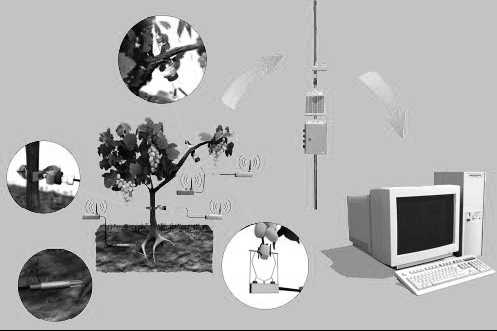Agriculture is the main income of the most people in developing countries. Therefore
improvement of this field is directly affecting the development of the economy of
the country. It is worth to find out new approach to improve agricultural efficiencies.
Sensors, such as yield monitors, and remote sensed images are helping farmers’
better manage their land. Linking sensors to not only record, but act on information,
further improves efficiencies. For example, sensors that detect weeds and spray them
reduce herbicide use, and save time. Thus, water quality can be improved without
the expense of fencing. Sensors linking temperature, balance, pressure, motion,
tension, flow, moisture, or pests (bacteria, fungi, insects, rodents) to time and location
will aid the agricultural manager. Groups of sensors, varying in type, will
provide added value. In agriculture, sensor systems must be reliable, easy to use,
cost effective, and deliver the information in a timely and consumable way. Wireless
communication systems tied to the Internet will likely be agriculture’s sensor
communication backbone. Keeping the nation’s agriculture healthy is important for
our nation both economically and environmentally. Sensors are playing a key role
for do that.

In agriculture it should be have knowledge of the soil and crop characteristics.
Traditional soil and plant sampling and analysis methods are very expensive, tedious,
and time consuming for obtaining soil and crop parameters on an agricultural field
and at a short time scale. Sensors capable of gathering information quickly are
needed. They will be particularly useful to measure parameters that vary faster
in time, such as nitrogen and soil water content (Figure: 1) . Sensors are being
developed and used for the following applications:
Different technologies are in development. The most prominent are those based
on electromagnetic induction, electric conductivity, ion selective field effect transistors,
optoelectronic sensors, ultrasonic displacement sensors, vision systems, and the
combination of these technologies. Contact sensors, ultrasonic sensors, force, pressure,
linear displacement, and optoelectronic sensors are usually applied to obtain
indirectly the flow of produces in the combine and to evaluate the yield on the go.
With ground level soil moisture sensor networks, growers can tell in real time exactly
how much irrigation is required and when. The sensor network can even turn on an
irrigation system automatically when soil moisture reaches a certain threshold. It
not only saves water it can be get higher yields because they’re able to keep moisture
at a consistent level.
improvement of this field is directly affecting the development of the economy of
the country. It is worth to find out new approach to improve agricultural efficiencies.
Sensors, such as yield monitors, and remote sensed images are helping farmers’
better manage their land. Linking sensors to not only record, but act on information,
further improves efficiencies. For example, sensors that detect weeds and spray them
reduce herbicide use, and save time. Thus, water quality can be improved without
the expense of fencing. Sensors linking temperature, balance, pressure, motion,
tension, flow, moisture, or pests (bacteria, fungi, insects, rodents) to time and location
will aid the agricultural manager. Groups of sensors, varying in type, will
provide added value. In agriculture, sensor systems must be reliable, easy to use,
cost effective, and deliver the information in a timely and consumable way. Wireless
communication systems tied to the Internet will likely be agriculture’s sensor
communication backbone. Keeping the nation’s agriculture healthy is important for
our nation both economically and environmentally. Sensors are playing a key role
for do that.

(Figure 1)
In agriculture it should be have knowledge of the soil and crop characteristics.
Traditional soil and plant sampling and analysis methods are very expensive, tedious,
and time consuming for obtaining soil and crop parameters on an agricultural field
and at a short time scale. Sensors capable of gathering information quickly are
needed. They will be particularly useful to measure parameters that vary faster
in time, such as nitrogen and soil water content (Figure: 1) . Sensors are being
developed and used for the following applications:
- ˆ Soil Properties Sensing: Soil Texture, Structure, and Physical Condition; Soil Moisture; Soil Nutrients.
- ˆ Crop Sensing: Plant Population; Crop Stress and Nutrient Status.
- ˆ Yield Monitoring Systems: Crop Yield; Harvest Swath Width; Crop Moisture
- ˆ Variable Rate Technology Systems: Fertilizer flow; Weed detection, pressure
Different technologies are in development. The most prominent are those based
on electromagnetic induction, electric conductivity, ion selective field effect transistors,
optoelectronic sensors, ultrasonic displacement sensors, vision systems, and the
combination of these technologies. Contact sensors, ultrasonic sensors, force, pressure,
linear displacement, and optoelectronic sensors are usually applied to obtain
indirectly the flow of produces in the combine and to evaluate the yield on the go.
With ground level soil moisture sensor networks, growers can tell in real time exactly
how much irrigation is required and when. The sensor network can even turn on an
irrigation system automatically when soil moisture reaches a certain threshold. It
not only saves water it can be get higher yields because they’re able to keep moisture
at a consistent level.


No comments:
Post a Comment